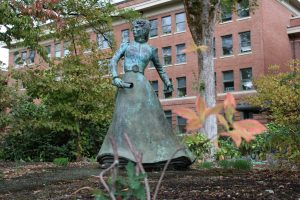“Knowledge can be imperfect and built together:” Supplemental instruction tables return this fall
October 18, 2022
Free, supportive, uninterrupted study time for an hour a week? Sounds like heaven to any college student. Here at Oregon State University, the Academic Success Center offers a program that has just that!
The Supplemental Instruction program here has a 20-year history, and with that, almost a decade’s worth of data that Christopher Gasser, the coordinator for SI tables at OSU, said shows the benefits of these tables, from students finding a sense of belonging to improved test scores– almost half a grade higher.
SI groups are offered in a variety of classes such as chemistry, math, economics, psychology and more. They meet once a week for 50 minutes during weeks two through 10. Tables are each led by a student who has taken the class, succeeded in it and volunteered to help teach it to others. These tables are interactive groups with around 10 students in them, allowing for students to get more focused and personalized help.
In addition to getting more personalized help, working in SI groups allows students to work through more challenging problems without the fear of failure or a suffering grade. Instead, they can work through assignments step by step and get a detailed understanding of concepts before moving on. Working with SI leaders who were students in the class often allows current students to understand complex topics in a different way that might better suit them, allowing for more success in the class.
“They’re getting the same information, but explained in a different way,” explained Madeline Courville, a fourth-year psychology major and SI leader for the Chemistry 23x series.
In these groups, leaders will refer to recent class work and work directly with the class professors to ensure students are practicing relevant and accurate problems. Before the term starts, Ai Ana Richmond, a fourth-year zoology major and SI instructor for the Biology 22x series, said leaders go through training.
“We talk about pedagogy, and how to teach and how to learn and all of the theory behind it… It ended up being this really interesting study of education, it was really helpful,” Richmond said.
Gasser said one of the benefits of joining a SI group is the community.
“Before college, we often think about learning happening individually and SI sort of breaks that a little bit, and celebrates that there is community in learning and that knowledge can be imperfect and built together,” Gasser said. “It really gives people a place to belong that both focuses on the content and a sense of belonging and sense of community.”
Participating in SI groups also allows students to connect more with not only their classes, but also their college.
“Reaching out and finding space for [SI groups] to take place, we’ve been intentional about not having them all be in a single location,” said Adam Lenz, assistant coordinator for SI.
“We actually prefer they’re a little spread out around campus because we find that is it really valuable for students that are taking courses in certain programs to continue to build a sense of belonging, not only with SI but simultaneously build a sense of belonging in that program and with the major based on the building and location that they’re studying in.”
Students aren’t the only people who enjoy attending these tables. So do the leaders.
Blake Lee, a Chemistry 23X SI leader, said one of the best parts of being an SI leader was “getting to see individuals who [he] had in Chemistry 231 all the way through Chemistry 233 and getting to see that they passed the course that I was helping them with,” Lee said. I have people come back to me.I do these little quizzes at the end and I have a bunch of positive feedback from that stuff and some negative too, but it’s constructive.”
Richmond commented on the way the work helps not only the students but also can be helpful to the instructors.
“We only have them for nine weeks but watching that transformation and that shift in confidence and the relationships that build amongst [has] made me a better student and just a better person,” Richmond said. “I’m constantly in a state of my own learning and reflection and it’s cool to see that.”
To Courville, the best part is “seeing the difference that you’re making for some students.”
More information about SI tables, their benefits and how to get started is available on the ASC website, https://success.oregonstate.edu/.






